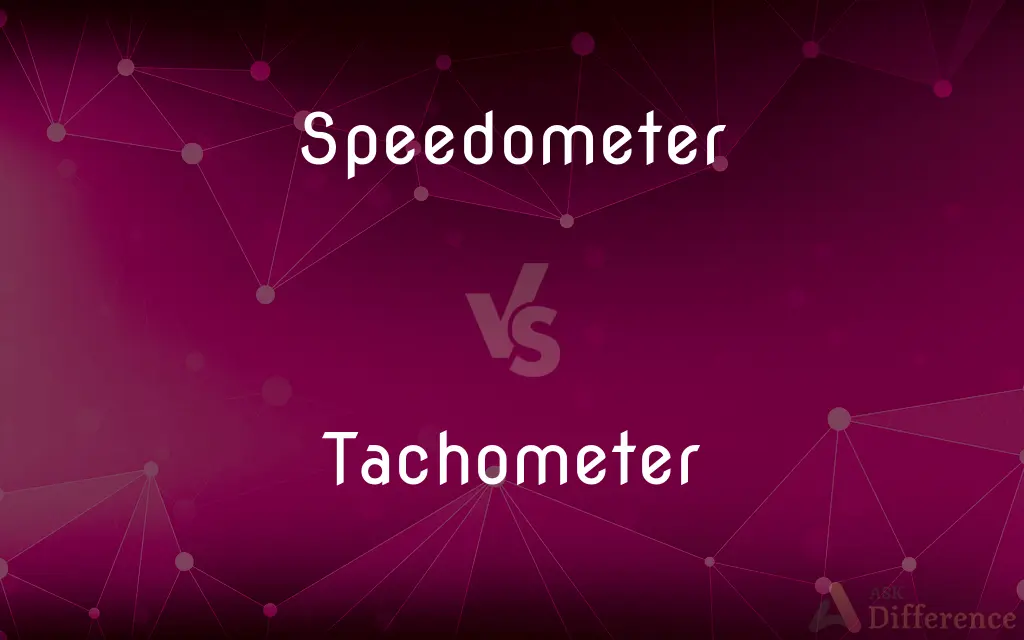Speedometer vs. Tachometer — What's the Difference?
By Tayyaba Rehman — Updated on June 12, 2024
A "speedometer" measures a vehicle's speed, usually in mph or km/h, while a "tachometer" indicates engine revolutions, often in RPM.

Difference Between Speedometer and Tachometer
Table of Contents
ADVERTISEMENT
Key Differences
"Speedometer" and "tachometer" are both crucial instruments found in vehicles, but they measure different aspects. A "speedometer" provides the driver with a real-time reading of the vehicle's speed. Whether you're driving a car, motorcycle, or truck, the speedometer aids in ensuring you're within legal and safe limits. The unit of measure is typically miles per hour (mph) in the U.S. or kilometers per hour (km/h) elsewhere. On the contrary, a "tachometer" focuses on the engine's performance. It tracks the number of rotations the engine's crankshaft makes per minute, abbreviated as RPM (revolutions per minute). While the "speedometer" relates to the vehicle's movement, the "tachometer" offers insights into engine health and efficiency.
The essence of a "speedometer" is to offer information pertinent to road safety and traffic rules. As you speed up or slow down, the needle or digital reading adjusts accordingly, assisting drivers in adapting to speed regulations. Conversely, a "tachometer" doesn't directly link to speed. Instead, it gives drivers an understanding of when to shift gears in manual vehicles or alerts to potential engine issues.
To summarize, while both instruments are dashboard staples, they serve distinct functions. The "speedometer" is all about velocity, aiding drivers in adhering to speed limits. The "tachometer", meanwhile, revolves around the engine, guiding optimal gear shifts and highlighting potential engine concerns.
Comparison Chart
Function
Measures vehicle speed
Measures engine revolutions
Typical Unit
MPH (miles per hour) or km/h (kilometers per hour)
RPM (revolutions per minute)
ADVERTISEMENT
Relation
Pertains to vehicle's movement on a road
Relates to engine's internal performance
Importance
Helps adhere to speed limits
Indicates when to shift gears; flags potential engine issues
Location
Found on all road vehicles' dashboards
Common in cars, especially with manual transmissions
Compare with Definitions
Speedometer
An instrument indicating vehicle speed.
The speedometer showed I was going 55 mph.
Tachometer
An instrument measuring engine revolutions.
The tachometer was hovering around 3,000 RPM.
Speedometer
Measures speed in mph or km/h.
The speedometer's needle was approaching 70 km/h.
Tachometer
Common in cars, especially manuals.
The car's tachometer had a red zone starting at 7,000 RPM.
Speedometer
Often analog with a needle or digital.
The car's digital speedometer displayed a clear 45.
Tachometer
Displays engine speed in RPM.
As I accelerated, the tachometer needle climbed.
Speedometer
A speedometer or speed meter is a gauge that measures and displays the instantaneous speed of a vehicle. Now universally fitted to motor vehicles, they started to be available as options in the early 20th century, and as standard equipment from about 1910 onwards.
Tachometer
Useful for manual gear shifts.
I shifted gears when the tachometer hit the redline.
Speedometer
An instrument on a vehicle's dashboard indicating its speed.
Tachometer
Can indicate engine health or stress.
The tachometer's high reading suggested the engine was overworking.
Speedometer
An instrument for indicating speed.
Tachometer
A tachometer (revolution-counter, tach, rev-counter, RPM gauge) is an instrument measuring the rotation speed of a shaft or disk, as in a motor or other machine. The device usually displays the revolutions per minute (RPM) on a calibrated analogue dial, but digital displays are increasingly common.
Speedometer
An instrument for indicating distance traveled as well as rate of speed.
Tachometer
An instrument which measures the working speed of an engine (especially in a road vehicle), typically in revolutions per minute.
Speedometer
An odometer.
Tachometer
An instrument used to measure the rotations per minute of a rotating shaft.
Speedometer
An instrument located within the dashboard of a vehicle that measures and indicates the current speed of the vehicle.
Tachometer
A device for measuring the revolutions per minute (RPMs) of a revolving shaft, as with the driveshaft of an automobile.
Speedometer
Such a device incorporating an odometer.
Tachometer
A device for measuring or indicating velocity or speed, as of blood, a river, a machine, etc.
Speedometer
A meter fixed to a vehicle that measures and displays its speed
Tachometer
An instrument for measuring the velocity, or indicating changes in the velocity, of a moving body or substance.
Speedometer
Essential for adhering to speed limits.
I glanced at the speedometer to ensure I wasn't speeding.
Tachometer
An instrument for measuring the velocity of running water in a river or canal, consisting of a wheel with inclined vanes, which is turned by the current. The rotations of the wheel are recorded by clockwork.
Speedometer
Found in every road vehicle's dashboard.
The speedometer's backlight was dim, making it hard to read at night.
Tachometer
An instrument for showing at any moment the speed of a revolving shaft, consisting of a delicate revolving conical pendulum which is driven by the shaft, and the action of which by change of speed moves a pointer which indicates the speed on a graduated dial.
Tachometer
An instrument for measuring the velocity of the blood; a hæmatachometer.
Tachometer
Measuring instrument for indicating speed of rotation
Common Curiosities
Why is a "tachometer" essential in manual cars?
It helps drivers know when to shift gears.
If my "tachometer" consistently reads high, is there a problem?
It might indicate the engine is overworking or there's a need to shift.
Where are these instruments typically located?
Both are found on a vehicle's dashboard.
Can I drive without a functioning "speedometer"?
It's unsafe and potentially illegal to drive without a working speedometer.
Do both "speedometer" and "tachometer" measure speed?
The "speedometer" measures vehicle speed, while the "tachometer" measures engine revolutions.
Why do some vehicles lack a "tachometer"?
Some automatic or simpler vehicles might not have them, as they're more crucial for manual transmissions.
Is it common for both instruments to fail simultaneously?
No, but issues like a blown fuse could affect both.
What unit does a "speedometer" use in the U.S.?
It typically uses miles per hour (mph).
Is it possible for a "speedometer" to show incorrect speeds?
Yes, calibrations or mechanical issues can affect accuracy.
Does a "tachometer" read high in a fast-moving car?
Not necessarily; it reflects engine RPM, not vehicle speed.
Can a "speedometer" be digital?
Yes, modern cars often have digital speedometers.
Why do "tachometers" have a red zone?
It indicates RPM levels that are potentially harmful to the engine.
Why might a racer monitor the "tachometer" closely?
To optimize gear shifts and engine performance during a race.
Can I install an aftermarket "tachometer"?
Yes, especially for vehicles with manual transmissions or for tuning purposes.
Does every vehicle have a "speedometer"?
Virtually all road vehicles have a speedometer for safety and legal reasons.
Share Your Discovery

Previous Comparison
Management vs. Operation
Next Comparison
Mysterious vs. MysticAuthor Spotlight
Written by
Tayyaba RehmanTayyaba Rehman is a distinguished writer, currently serving as a primary contributor to askdifference.com. As a researcher in semantics and etymology, Tayyaba's passion for the complexity of languages and their distinctions has found a perfect home on the platform. Tayyaba delves into the intricacies of language, distinguishing between commonly confused words and phrases, thereby providing clarity for readers worldwide.
















































